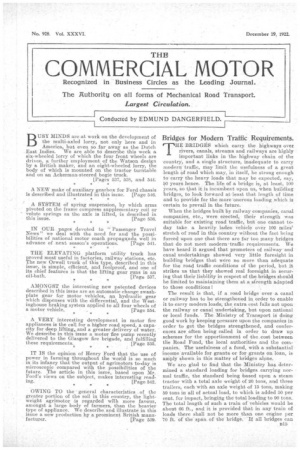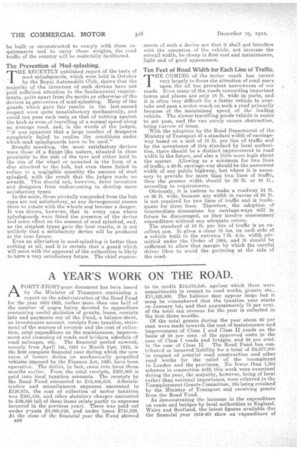Bridges for Modern Traffic Requirements.
Page 1

Page 2

If you've noticed an error in this article please click here to report it so we can fix it.
THE BRIDGES which carry the highways over rivers, canals, streams and railways are highly important links in the highway chain of the country, and a single structure, inadequate to carry modern traffic, may limit the usefulness of a great length of road which may, in itself, be strong enough to carry the heavy loads that may be expected, say, 50 years hence. The life of a bridge is, at least, 100 years, so Oat it is incumbent upon us, when building bridges, to look forward at 'least that length of time and to provide for the more onerous loading which is certain to prevail in the future.
When the bridges built by railway companies, canal companies, etc., were erected, their strength was suitable for existing road traffic, but one cannot today take a heavily laden vehicle over 100 miles' stretch of road: in this country without the fact being forced upon one that there are far too many bridges that do not meet modern' traffic requirements. We have heard it argued that promoters of railway' and canal undertakings showed very little foresight in building bridges that were no more than adequate for the road traffic conditions of the period, but it strikes us that they showed real foresight in securing that their liability in respect of the bridges should be limited to maintaining them at a strength adapted to those conditions! , The result is that, if a road bridge over a canal or railway has to be strengthened in order to enable it to carry modern loads, the extra cost falls not upon the railway or canal undertaking, but upon national or local funds. The Ministry of Transport is doing good work by keeping pressure upon the companies in order to get the bridges strengthened, and conferences are often being called in order to draw up schemes for the apportionment of the cost between the Road Fund, the local authorities and the companies. The usefulness of a fund, with a substantial income available for grants or for grants on loan, is amply shown in this matter of bridges alpue.
We are glad to find that the Ministry has determined a standard loading for bridges carrying normal traffic, the standard being based upon a steam tractor with a total axle weight of 20 tons, and three trailers, each with an axle weight of 13 tons, making 59 tons in all of actual load, to which is added 50 per cent, for impact, bringing the total loading to 90 tons. The total length of such a train of vehicles would be about 66 ft., and it is provided that in any train of loads there shall not be more than one engine per 70 ft. of thespan of the bridge. If all bridges can
be built or reconstructed to comply with these requirements and to carry these weights, the road traffic of the country will be materially facilitated.
The Prevention of Mud-splashing.
THE RECENTLY published report of the tests of mud splashguards, which were held in October by the Royal Automobile Club, shows that the majority of the inventors of such devices have not paid sufficient attention to the fundamental requirements, quite apart from the merits or otherwise of the devices as preventers of mud-splashing. Many of the guards which gave fair results in the last-named respect were quite unsatisfactory mechanically, and could not pass such tests as that of rubbing against the kerb or even of travelling at a normal speed along an average road, and, in the word S of the judges, " it was apparent that a large number of designers completely failed to realize the conditions under which mud splashguards have to be used."
Broadly speaking, the most satisfactory devices were those of a flange-like nature, situated in close proximity to the side of the tyre and either held to the rim of the wheel or mounted in the form of a disc attached to the hub, but even these failed to reduce to a negligible quantity the amount of mud splashed, with the result that the judges made no awards. This should not, however, deter inventors arid designers from endeavouring to develop more satisfactory types.
In the main, those pivotally suspended from the hub caps are not satisfactory, as any derangement causes them to rotate with the wheels and become a danger. It was shown, however, that in every case where splashguards were fitted the presence of the device had some effect on the amount of mud splashed, and, as the simplest types gave the best results,. it is not unlikely that a satisfactory device will be produced in the near future_
Even an alleviation in mud-splashing is better than nothing at all, and it is certain that a guard which -will meet with the approval of the authorities is likely to have a very satisfactory future. The chief require
ments of such a device are that it shall not interfere with the operation of the vehicle, not increase the overall width, be cheap in first cost and maintenance, light and of good appearance.
Ten Feet of Road Width for Each Line of Traffic. THE COMING of the motor coach has served very largely to focus the attention of road users upon the all too prevalent narrowness of our roads. Even many of the roads connecting important towns and places are only 18 ft. wide in parts, and it is often very difficult for a faster vehicle to overtake and pass a motor coach on such a road primarily because of the maintained speed of the leading vehicle. The slower-travelling goods vehicle is easier to get past, and the van rarely causes obstruction; being narrow of beam.
With the adoption by the Road Department of the Ministry of Transport of a standard width of carriageway based on a unit of 10 ft. per line of traffic and by the acceptance of this standard by local authorities, there should be a distinct improvement in road width in the future, and also a little more logic about the matter. Allowing as a minimum for two lines of traffic, a 20-ft. carriage-way should be the narrowest width of any public highway, but Where it is necessary to provide for more than two lines of traffic, then the greater width should be 30 ft. or 40 ft, according to requirements.
Obviously, it is useless to make a roadway 24 ft. or 26 ft. wide because any width in excess of 20 ft. is not required for two lines of traffic and is inadequate for three lines. Therefore, the adoption of intermediate dimensions for carriage-ways will in future be discouraged, as they involve unnecessary expenditure without any adequate return.
The standard of 10 ft. per line of traffic is an excellent one. It gives a clear 15 ins, on each side /of a vehicle built to the extreme "7-ft. 6-in, width permitted under the Order of 1904, and it should be sufficient to allow that margin by which the careful driver likes to avoid the guttering at the side of the road.,




























